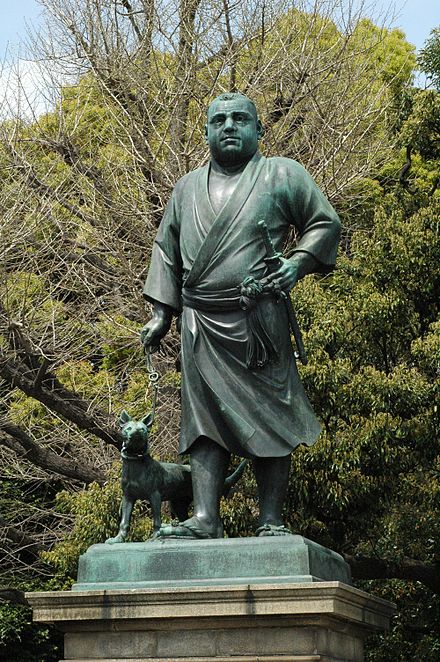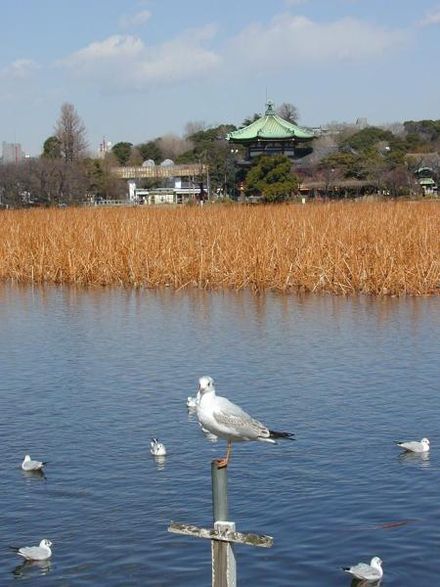Tokyo/Ueno - town located in Taitō-ku, Tokyo
If you want to get a feel for old Tokyo, Ueno () in the Taito district is a good place to start. Entirely lacking in high-rise condos or whiz-bang shopping malls, by Tokyo standards it's distinctly downmarket, in contrast to places like Ginza, but that means that eating, shopping and drinking are all affordably priced. Safety is not an issue, but the areas to the southwest of Ueno station has a high density of sex-clubs with active bouncers and prostitutes soliciting their trade. Ueno has excellent connectivity not just around Tokyo, but to all of northern Japan as well. Several major museums and other cultural sites are conveniently located to the northwest of the well-connected station.
Understand
Tourist office
- Tokyo Tourist Information Center Keisei Ueno Branch, in the Keisei train station outside the ticket gates, +81 3-3836-3471. Daily 09:30-18:30. A good source of tourist information, this office is geared for foreign visitors, so all materials are in languages other than Japanese and all staff speak English.
Get in
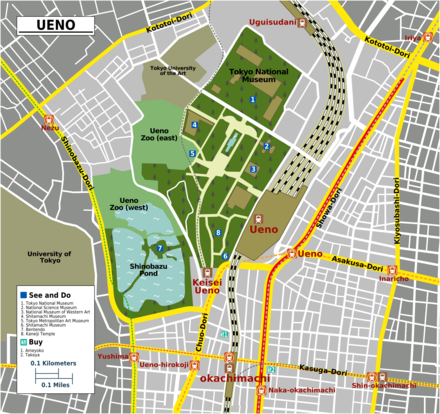
Ueno Station (上野駅 Ueno-Eki) was at one time the place from which steam locomotives chugged off to the snowy northeast, but nowadays the highspeed Shinkansen just make a brief stop. The JR Joban Line, which connects with the prefectures to the north still terminate here though. All local trains on the JR Yamanote and Keihin-Tohoku lines stop here as well. The Keisei Skyliner and most Keisei limited expresses from Narita Airport terminate at Keisei Ueno Station, just south of the larger JR station.
Tokyo Metro's Hibiya and Ginza subway lines (stations H-17 and G-16) underpin both stations, with direct connecting passages to each.
Stations around Okachimachi (御徒町) are within walking distance to Ueno park, where you will find most of the major attractions in the area. Both of Okachimachi Station (御徒町駅) on the JR Yamanote line and JR Joban line and Naka-okachimachi Station (仲御徒町駅, H-16) on the Tokyo Metro Hibiya line are tightly connected to Ueno Station via the Ameyoko bazaar - walking through the street you can shop for souvenirs. Ueno-okachimachi Station (上野御徒町駅, E-09) on the Toei Oedo subway line connects Ueno directly with Ryogoku in the Sumida district in about 10 minutes.
See

Tokyo National Museum
Tokyo National Museum (東京国立博物館 Tōkyō kokuritsu hakubutsukan), 35.718997°, 139.776333°, +813-38822-111. Tu-Su 09:30-17:00 year round; Mar-Dec: F to 20:00; Mar-Aug: Sa Su to 18:00. JR lines to Ueno, Ueno-kōen exit. Adult ¥620, student ¥410, child & senior free. Special exhibitions charge separate admission fees
A gigantic complex that houses almost 100,000 art objects covering Japanese history from the Jomon period to the 20th century. Some descriptions are in English. Admission includes access to the following buildings:
- Honkan is the main museum which is notable for the breadth of its displays. It displays works of artistic and historical value value, including Buddhist statues, calligraphy, tea ceremony art, swords and armor, folding screen artwork, noh and kabuki-related items, and ukiyo-e woodblock prints.
- Heiseikan is an archaeological museum which displays excavated items, such as pottery and burial statues from early periods. Heiseikan also houses special exhibitions.
- Toyokan exhibits art from east Asia, India and Egypt.
- The Gallery of Horyuji Treasures houses art donated by Horyuji temple (near Nara) in 1878. The modern museum building, designed in 1999 by Yoshio Taniguchi, is worth a visit for its own architectural merits.
Museums

- National Museum of Western Art (国立西洋美術館, Kokuritsu Seiyō Bijutsukan?), 35.715278°, 139.775833°. Daily 09:30-17:00. Houses an extensive collection of Western art, including the original of Rodin's famous The Thinker. It is listed as a UNESCO World Heritage as part of "The Architectural Work of Le Corbusier, an Outstanding Contribution to the Modern Movement". Entry ¥420; free admission on the 2nd and 4th Saturdays of each month
- National Science Museum (国立科学博物館 Kokuritsu kagaku hakubutsukan), 35.716387°, 139.776247°. It focuses on the living world, with life-sized representations of practically every life form the earth has ever seen, from the blue whale (outside the old building) to hundreds of exotic insects. There are also sections covering technology, the physical sciences, and hands-on exhibits for children, as well as the stuffed and mounted body of Hachiko, of Shibuya statue fame. In 2012, it re-opened in a new building.
- Shitamachi Museum (下町風俗資料館), 35.710298°, 139.772685°. A small museum that offers a glimpse into life in the area in the early 20th century, with re-created houses and stores, and cultural artifacts.
Other
- Saigō Takamori Statue (西郷隆盛像), 35.71184°, 139.77418°. Near the main entrance to the park from JR station stands an unassuming statue of a pudgy man walking his dog. This is Saigō Takamori, a famous samurai general best known for leading the doomed Satsuma Rebellion against the Meiji government (and the inspiration for Hollywood blockbuster The Last Samurai). These days, it's the canonical place for meeting people at the park.
- Ueno Zoo (上野動物園), 35.7175°, 139.771389°. Tu-Su 09:30-17:00 (last entry 16:00). Has over 300 animals. Most Japanese people come here to see the two pandas Lili and Shinshin. There was much excitment in 2012 after the birth of a baby panda at the zoo but he died a few days after birth. ¥600
- Shinobazu Pond (不忍池 Shinobazu-ike), adjacent to Ueno Park, 35.711019°, 139.77075°. Full of water lilies and waterfowl and has the picturesque little Bentendō Hall shrine, dedicated to the goddess Benzaiten, in the middle.
- Former Iwasaki Family House and garden (旧岩崎邸庭園, Kyū-Iwasaki-tei Teien), 1-3-45, Ikenohata (on a side street between Ueno Park and Tokyo University Hospital; look for small blue directional signs), 35.70972°, 139.76778°. Not a major tourist attraction, but an interesting bit of history. The house was built in the Meiji era in the style of an American or British mansion. In WWII the fire raids consumed most of the houses behind the mansion, which was used by GHQ during the occupation. A few attached Japanese-style rooms remain. Sit and sip green tea. The garden--mostly lawn and trees--is of no great interest.
Do
City Walk
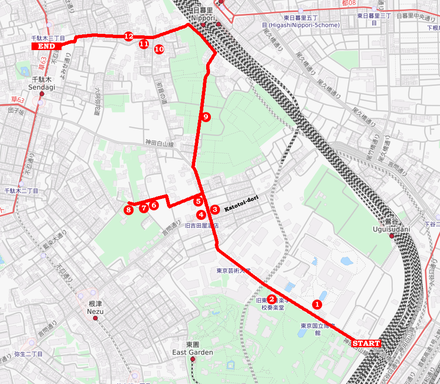 | |
|
| START Tokyo National Museum |
| END Sendagi Station |
| LENGTH approx. 3 km; two hours |
| |
|
| START Tokyo National Museum |
| END Sendagi Station |
| LENGTH approx. 3 km; two hours |
Start from Tokyo National Museum before you start exploring Yanaka, with its temples, galleries and old wooden buildings. If not, simply follow the road north-west out of Ueno-kōen until you hit Katotoi-dōri. At the corner is the Shitamachi Museum Annexe, actually a preserved, century-old liquor store. Across the street is Kayaba Coffee, if you need a pick-me-up.
From here, it's a short walk to SCAI the Bathhouse, a classic old public bathhouse turned contemporary art gallery. It's a worthwhile detour to continue down to Edokoro, the studio of painter Allan West, and to see the ancient, thick-trunked Himalayan cedar tree on the corner. In and around here, you'll pass many temples, including Enju-ji, where Nichika-sama, the 'god of strong legs' in enshrined; this is popular with runners. Feel free to stop in any temples; just be respectful and keep your voice low.
Now double back towards the entrance of Yanaka-reien, one of Tokyo's most atmospheric and prestigious cemeteries (also a favourite sunning spot of the neighbourhood's many stray cats). When you exit the cemetery, continue with the train tracks on your right, climbing until you reach the bridge, which overlooks the tracks. This is naturally a favourite destination for trainspotters (360° photo for this spot).
Head left and look for the sign pointing towards the Asakura Museum of Sculpture, Taitō, the home studio of an early-20th-century sculptor and now an attractive museum. Back on the main drag, continue down the Yūyake Dandan (literally Sunset Stairs) to the classic mid-20th-century shopping street, Yanaka Ginza. Pick up some snacks from the vendors here, then hunker down on a milk crate on the side of the road to eat with the locals, where there is also a beer stand if you'd like to wash it down. Walk west and you can pick up the subway at Sendagi Station.
Buy
- Ameyoko (アメ横), 35.71099°, 139.77452°. A packed shopping bazaar full of stalls selling almost anything you can imagine. It runs roughly south of Ueno station along the inside of the JR Yamanote line tracks to Okachimachi station. If you are looking for a more typically "Asian" market street in Tokyo, with bargaining expected and friendly vendors trying to out-shout each other, this is it. Definitely a good place for souvenirs for friends back home. It is often mistakenly believed that the district got its name in the post-war years from the American blue jeans and other items that were sold on the black market, but really the 'ame' comes from the sweets (ame in Japanese) that were sold there.
Eat
There's plenty of cheap food to be found all around Ueno station, including a large number of food stalls near the shrine on Shinobazu Lake.
In cherry blossom season, the local favorite is grilled rice dumplings known as dango (団子), slathered with either a sweet and salty soy-based sauce or chunky red bean paste. As the terse Japanese proverb says, Hana yori dango, or "Dumplings are better than blossoms".
Budget
- Okina An (翁庵), 35.711842°, 139.778859°. 11:00-20:00. One of the most authentic soba places in Tokyo. The owner keeps the place clean but has not renovated anything since the Showa era. Note the cash register from the 1960s and the museum-worth tea hearth. Try negiseiro, which is buckwheat noodles with tempura-style soup. Put the onions and some wasabi in your soup, then put a bit of soba into your soup and slurp it. When you're done, pour the sobayu into your soup and drink. ¥750
- Yayoiken (やよい軒), Higashi-Ueno 3-37-9 (on Asakusa-dori, 2 min from JR Ueno), 35.711685°, 139.779489°, +81 3-5846-6175. 07:00-23:00. Cheap and cheerful grills served on a hot teppan iron plate, with all the rice you can eat. Plastic food models plus a coupon machine with pictures make ordering easy. Morning sets from ¥350, full meals from ¥580
- Juraku (じゅらく), 6-11-11, Ueno (In front of Ueno Station at Shinobazu Exit across the street), 35.711403°, 139.774674°, +81 3-3831-8452. 11:00-22:00. An affordable restaurant popular for families. Serves omelettes, hamburg steaks among other Western and some Japanese dishes. No credit cards accepted. around ¥1,000
- Ueno Yabusoba (上野藪そば). Another traditional soba place. Seiro for ¥740 2016-02-07
- Yoshinoya, 35.71238°, 139.77782°. A popular beef rice bowl chain. From ¥¥380 2016-09-20
Mid-range
- Izuei (伊豆栄), 2-12-22, Ueno (2 min from Ueno Station into Ueno Park), 35.709780°, 139.772626°, +81 3-3831-0954. 11:00-21:30. Opened circa 1750, an authentic eel place. Lunch from ¥2,100, dinner from ¥7,300
- Tonkotsu Ramen Restaurant, 35.71229°, 139.77502°. A popular ramen chain. From ¥1000 2016-09-26
Splurge
- Ueno Seiyōken (上野精養軒), in the Ueno Park grounds (1 min from Ueno Station into Ueno Park), 35.711728°, 139.774251°. Opened in 1877, this was one of the first Western restaurants in Japan, serving French cuisine befitting its stature. Lunch from ¥2400, dinner from ¥10,000
Drink
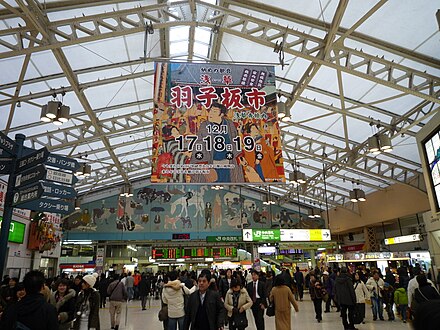
"Without sake, what is the meaning of cherry blossoms?", proclaims a famous haiku poem. The profound truths contained within are experimentally tested every spring, when more or less all of Ueno Park disappears under a sea of blue tarps, picnicking secretaries and sozzled salarymen.
- Tōrindō (桃林堂), Ueno-sakuragi 1-5-7. 09:00-17:00. A little off the beaten track but just a short walk from the Tokyo National Museum, this traditional shop serves tea ceremony tea (¥450) without the ritualized fuss and delectable Japanese desserts (from ¥150) to go with them.
- Tasuichi (plus one). Down the street from the 0101(Marui) department store is an extremely small but very friendly stand-up bar. They serve good food, have cheap drinks, speak some English, and are very friendly to foreigners. A great place to go if you are traveling by yourself, know some very basic Japanese and want to make friends with a local or two, but this is not a club. The surrounding area is filled with similar places.
- The Warrior Celt (550 m south of Ueno station, past Marui dept.store), 3rd floor, Ito Bld, 6-9-22 Ueno, +81 3-3836-8588. Known locally as the hangout for a few good beers in a typical Irish pub atmosphere. Expat crowd as well as Japanese drinkers. Say you found the place off Wikivoyage for a little something special. ¥600-1000
Sleep
Only hotels within walking distance of Ueno Station are listed here. See Taito for a listing of hotels elsewhere in the district.
- Sutton Place Hotel Ueno (サットンプレイスホテル), 7-8-23, Ueno, Taito-ku (from JR Ueno station, Iriya exit, cross the street to Iwakura High School; continue to the end of that block; turn left at the next traffic light; hotel is on the left; 2 min walk total), 35.713956°, 139.779074°, +81 3 3842-2411. Check-in: 15:00, check-out: 12:00. Mid-range hotel, in the Renaissance Group. Rooms have en-suite toilet. Staff speaks English. Breakfast included. Free internet access in the lobby. The hotel is in a quiet street in Ueno, 2 minutes walking from JR Ueno Station and 5 minutes walking from subway Ueno Station. From Keisei Ueno, terminating station of the Skyliner from Narita Airport, the walk is about 10 minutes. ¥7000
- Kinuya Hotel (きぬやホテル), 2-14-28 Ueno, Taito-ku (3 minutes walk from JR Ueno Shinobazu exit), 35.711008°, 139.772916°. A great hotel for backpackers, staff can speak English. Two PCs with internet access are available at the lobby. Singles for ¥7400
- Mitsui Garden Hotel Ueno (三井ガーデンホテル上野), 3-19-7 HigashiUeno (2 minutes walk from the Asakusa Exit of JR Ueno Station), 35.711864°, 139.778109°, +81 3-3839-1131. ¥16,800 twin room per night
- Hotel Coco Grand Ueno Shinobazu, 2-12-14 Ueno Taito, 35.709440°, 139.771570°, +81 3-5812-1155.
- Ueno Hotel, 35.71610°, 139.78057°, +81 3-6231-7610. 8-minute walk from Ueno Station. 2016-09-20
Connect
Free Wifi
- Taito Free Wi-Fi, +81 570-015-152. The Wifi Serviced Taitō ward.
Stay safe
Ueno is home to one of Tokyo's major red light areas and thus has a somewhat more sketchy atmosphere than most of the city. Compared to similar areas in most countries, however, it is very safe and you are unlikely to run into trouble. Do be careful of hawkers trying to pull you into a bar, though, as this is likely to be a snack which will charge an extortionate seating fee.
African scammers are known to operate in market areas and try to push their merchandise (usually overpriced, low quality, stolen or counterfeit) on foreigners. While usually not violent, these African scammers usually have connections with organized crime and best to be avoided and ignored. Ueno is also known for being frequented by fake Buddhist monks. They will give you a trinket and then a piece of paper saying it is the treasure of their temple and they would like a donation to rebuild said temple. This is a lie, they are known to be an organized begging gang with no religious affiliation who specifically target obvious foreigners.
Go next
Ueno
Timezone:MultiplePopulation:3,710Coordinates:35.72, 139.77
